 W
WAlphaServer is the name given to a series of server computers, produced from 1994 onwards by Digital Equipment Corporation, and later by Compaq and HP. As the name suggests, the AlphaServers were based on the DEC Alpha 64-bit microprocessor. Supported operating systems for AlphaServers are Tru64 UNIX, OpenVMS, MEDITECH MAGIC and Windows NT, while enthusiasts have provided alternative operating systems such as Linux, NetBSD, OpenBSD and FreeBSD.
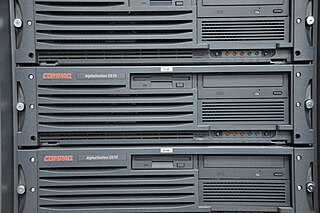 W
WAlphaStation is the name given to a series of computer workstations, produced from 1994 onwards by Digital Equipment Corporation, and later by Compaq and HP. As the name suggests, the AlphaStations were based on the DEC Alpha 64-bit microprocessor. Supported operating systems for AlphaStations comprise Tru64 UNIX, OpenVMS and Windows NT. Most of these workstations can also run various versions of Linux and BSD operating systems.
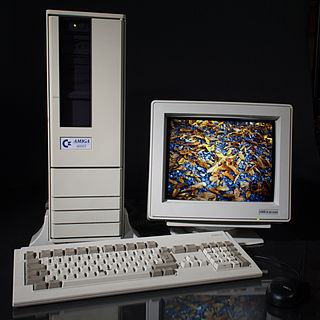 W
WThe Amiga 4000T, also known as A4000T, is a tower version of Commodore's A4000 personal computer. Using the AGA chipset, it was originally released in small quantities in 1994 with a 25 MHz Motorola 68040 CPU, and re-released in greater numbers by Escom in 1995, after Commodore's demise, along with a new variant which featured a 50 MHz Motorola 68060 CPU. Despite the subsequent demise of Escom, production was continued by QuikPak in North America into at least 1997.
 W
WBatterUP is a "24-inch foam-covered plastic" baseball bat-shaped controller manufactured for the personal computer, Sega Genesis, and the Super Nintendo Entertainment System by Sports Sciences Inc.
 W
W.bh is the Internet country code top-level domain (ccTLD) for Bahrain. It is administered by Telecommunications Regulatory Authority of Bahrain.
 W
WConflict Catcher is a discontinued utility software application that was written by Jeff Robbin and published by Casady & Greene for classic Mac OS. It aided Macintosh users in solving operating system conflicts with extensions and control panels. Conflict Catcher included a printed manual written by David Pogue.
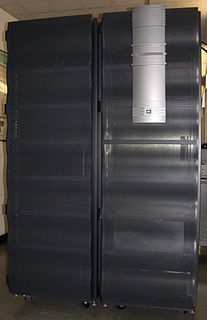 W
WThe Cray J90 series was an air-cooled vector processor supercomputer first sold by Cray Research in 1994. The J90 evolved from the Cray Y-MP EL minisupercomputer, and is compatible with Y-MP software, running the same UNICOS operating system. The J90 supported up to 32 CMOS processors with a 10 ns clock. It supported up to 4 GB of main memory and up to 48 GB/s of memory bandwidth, giving it considerably less performance than the contemporary Cray T90, but making it a strong competitor to other technical computers in its price range. All input/output in a J90 system was handled by an IOS called IOS Model V. The IOS-V was based on the VME64 bus and SPARC I/O processors (IOPs) running the VxWorks RTOS. The IOS was programmed to emulate the IOS Model E, used in the larger Cray Y-MP systems, in order to minimize changes in the UNICOS operating system. By using standard VME boards, a wide variety of commodity peripherals could be used.
 W
W.cy is the country code top-level domain (ccTLD) for Cyprus. Registration is limited to residents of Cyprus or companies and organizations registered with the government there; the personal or business registration number is required on registration. Some additional restrictions exist for various subdomains, but .com.cy is unrestricted to Cypriot entities.
 W
WThe HP 200LX Palmtop PC, also known as project Felix, is a personal digital assistant introduced by Hewlett-Packard in August 1994. It was often called a Palmtop PC, and it was notable that it was, with some minor exceptions, a MS-DOS-compatible computer in a palmtop format, complete with a monochrome graphic display, QWERTY keyboard, serial port, and PCMCIA expansion slot.
 W
WThe HP 200LX Palmtop PC, also known as project Felix, is a personal digital assistant introduced by Hewlett-Packard in August 1994. It was often called a Palmtop PC, and it was notable that it was, with some minor exceptions, a MS-DOS-compatible computer in a palmtop format, complete with a monochrome graphic display, QWERTY keyboard, serial port, and PCMCIA expansion slot.
 W
WThe IBM Simon Personal Communicator is a handheld, touchscreen PDA designed by International Business Machines (IBM), and manufactured by Mitsubishi Electric. BellSouth Cellular Corp. distributed the Simon Personal Communicator in the United States between August 1994 and February 1995, selling 50,000 units. The Simon Personal Communicator was the first personal digital assistant or PDA to include telephony features. The battery lasted only an hour, and flip phones became increasingly slim which led to its demise.
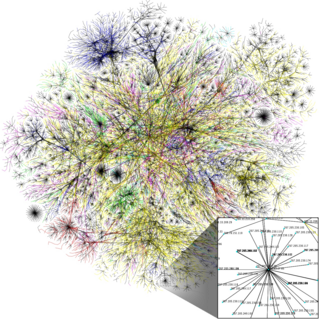 W
WChina has been on the internet intermittently since May 1989 and on a permanent basis since 20 April 1994. Although with limited access. In 2008, China became the country with the largest population on the Internet and has remained so since. As of July 2016, 730,723,960 people were internet users.
 W
WThe Macintosh Quadra 630 is a personal computer designed, manufactured and sold by Apple Computer, Inc. from July 1994 to October 1995. It was introduced as the replacement for the Quadra 610, and was the least-expensive computer in the Macintosh lineup with prices starting at $1,199 USD.
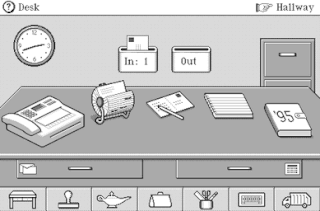 W
WMagic Cap is a discontinued object-oriented operating system for PDAs developed by General Magic. Tony Fadell was a contributor to the platform, while Darin Adler was an architect.
 W
WMotion capture is the process of recording the movement of objects or people. It is used in military, entertainment, sports, medical applications, and for validation of computer vision and robotics. In filmmaking and video game development, it refers to recording actions of human actors, and using that information to animate digital character models in 2D or 3D computer animation. When it includes face and fingers or captures subtle expressions, it is often referred to as performance capture. In many fields, motion capture is sometimes called motion tracking, but in filmmaking and games, motion tracking usually refers more to match moving.
 W
WThe Neo Geo CD is the second home video game console of SNK Corporation's Neo Geo family, released in September 9, 1994, four years after its cartridge-based equivalent. This is the same platform, converted to the cheaper CD format retailing at $49 to $79 per title, compared to the $300 cartridges. The system was originally priced at US$399, or £399 in the UK. The unit's 1× CD-ROM drive is slow, with very long loading times. The system can also play Audio CDs. All three versions of the system have no region-lock. The Neo Geo CD was launched bundled with a control pad instead of a joystick like the AES version. However, the original AES joystick can be used with all three Neo Geo CD models.
 W
WThe Power Macintosh, later Power Mac, is a family of personal computers designed, manufactured, and sold by Apple Computer, Inc. as part of the Macintosh brand from March 1994 until August 2006.
 W
WThe Power Macintosh 6100 is a personal computer designed, manufactured and sold by Apple Computer, Inc. from March 1994 to March 1996. It is the first computer from Apple to use the new PowerPC processor created by IBM and Motorola. The low-profile ("pizza-box") case was inherited from the Centris/Quadra 610 and 660AV models, and replaced the Macintosh Quadra series that used the Motorola 68040 processor, Apple's previous high-end workstation line.
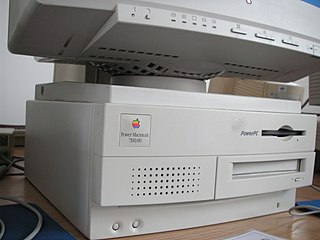 W
WThe Power Macintosh 7100 is a personal computer that was designed, manufactured and sold by Apple Computer Inc. from March 1994 to January 1996. It is the mid-range machine of the first generation of Power Macintosh line, between the Power Macintosh 6100 and the 8100. The 7100 re-used the Macintosh IIvx case with few changes. There were two versions of the 7100; the original 66 MHz version and an 80 MHz version that replaced it in January 1995. The 7100 was succeeded in August 1995 by two new models, the Power Macintosh 7200 and the Power Macintosh 7500, though sales of the 7100 continued into early 1996.
 W
WThe Power Macintosh 8100 is a personal computer that is a part of Apple Computer's Power Macintosh series of Macintosh computers. It was introduced in March 1994 alongside the Power Macintosh 6100 and the 7100 as the high end model of the first generation of the Power Macintosh family, and is a direct replacement of the prior Macintosh Quadra 800. It retains the Quadra 800's enclosure.
 W
WThe PowerBook 500 series is a range of Apple Macintosh PowerBook portable computers first introduced by Apple Computer with the 540c model on May 16, 1994. It was the first to have stereo speakers, a trackpad, and Ethernet networking built-in.
 W
W.sa is the Latin alphabet Internet country code top-level domain (ccTLD) of Saudi Arabia. Domains of this type can be registered through SaudiNIC, a department of the Communications and Information Technology Commission. The Arabic alphabet ccTLD of Saudi Arabia is السعودية.
 W
WThe Sound Blaster AWE32 is an ISA sound card from Creative Technology. It is an expansion board for PCs and is part of the Sound Blaster family of products. The Sound Blaster AWE32, introduced in March 1994, was a near full-length ISA sound card, measuring 14 inches (356 mm) in length, due to the number of features included.
 W
W.sv is the Internet country code top-level domain (ccTLD) for El Salvador.
 W
WTimex Datalink or Timex Data Link is a line of early smartwatches manufactured by Timex and is considered a wristwatch computer. It is the first watch capable of downloading information wirelessly from a computer. As the name implies, datalink watches are capable of data transfer through linking with a computer. The Datalink line was introduced in 1994 and it was co-developed with Microsoft as a wearable alternative to mainstream PDAs with additional attributes such as water resistance, that PDAs lacked, and easy programmability. The watch was demonstrated by Bill Gates on 21 June 1994 in a presentation where he downloaded information from a computer monitor using bars of light and then showed to the audience the downloaded appointments and other data. The early models included models 50, 70, 150 and model 150s. The model numbers indicated the approximate number of phone numbers that could be stored in the watch memory. These early models were, at the time of their introduction, the only watches to bear the Microsoft logo. The watches have been certified by NASA for space travel and have been used by astronauts and cosmonauts in space missions. There had been an evolution over the years as to the number and type of entries that can be stored in the various watch models as well as the mode of data transfer between computer and watch. At the time of its introduction the watch was considered high-tech.
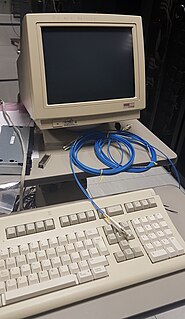 W
WThe VT520 is an ANSI standard computer terminal introduced by Digital Equipment Corporation (DEC) in 1993 and 1994. The VT520 is a multi-session monochrome text-only terminal with a built-in 14" monitor. The VT510 was a single-session version, while the VT525 added color support and used a separate external monitor.
 W
WThe Apple Workgroup Server 9150 is the only Apple Workgroup Server model not based on a desktop Mac. It featured an 80 MHz PowerPC 601 board in a Quadra 950 style case. The internal bay of the 950 case was filled with a tape backup drive. Atypically, the floppy drive was moved to the bottom of the case, the only Macintosh that ever used this configuration, and uses a regular Mac DA-15 video connector instead of the unusual internal video connector of the other early Power Macintoshes.
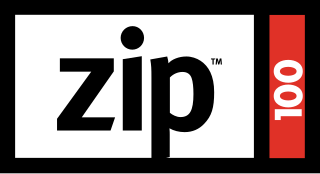 W
WThe Zip drive is a removable floppy disk storage system that was introduced by Iomega in late 1994. Considered medium-to-high-capacity at the time of its release, Zip disks were originally launched with capacities of 100 MB, then 250 MB, and finally 750 MB.